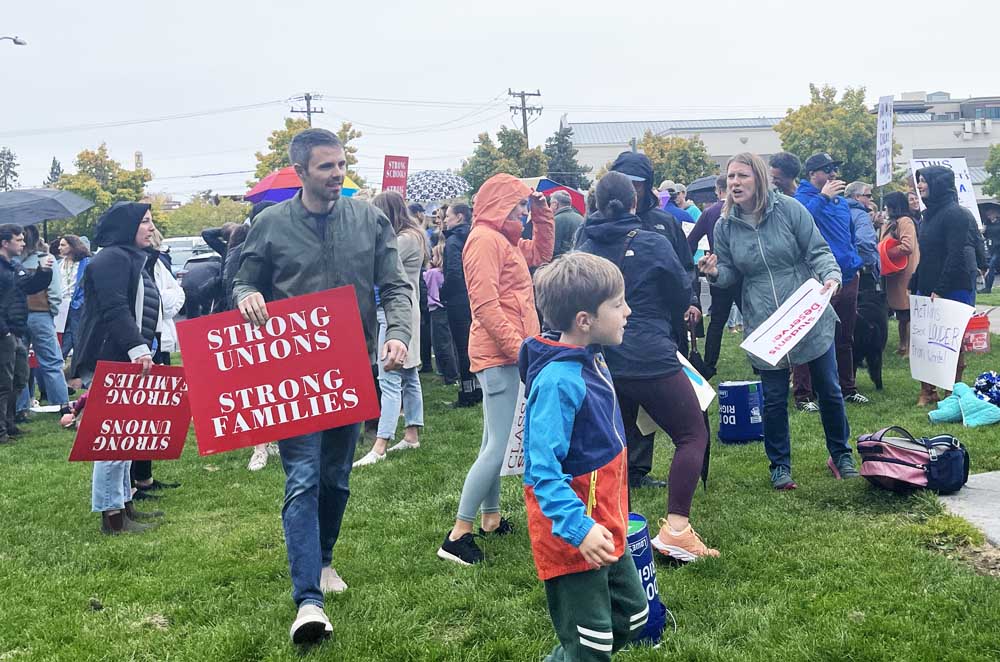BEA considering calling for mediation at end of January if no contract with school district
Published 5:30 am Thursday, January 11, 2024

- Teachers, children and community members hold signs in October during a Bend Education Association rally before the teacher's union met with the Bend-La Pine school district to continue negotiating a contract.
The Bend Education Association, the educators’ union for Bend-La Pine Schools, is considering mediation if a new contract with the district is not completed by the end of the month.
Full-day bargaining sessions since the school year began helped bring the two sides closer, but union members are frustrated and want to push for a fair contract, said union President Sarah Barclay. Their mood has recently deteriorated, she said.
“So, yes, there’s worry. But what I’m hearing is more frustration and anger that our employer is not treating us fairly and not treating us well and not getting this done,” said Barclay. “I’m hearing a lot of, ‘Keep pushing, we’re behind you, do what you need to do, we support you’ from our members and from educators.”
The district is also considering mediation as the next move.
“The District remains encouraged and hopeful that the parties can bridge the differences between them,” wrote Scott Maben, the district’s communications director, in an email. “We also agree that mediation would be the appropriate next step if the parties are unable to reach agreement in those sessions.”
Maben added that the district has made “substantial concessions in the latest round of bargaining and extended a generous financial offer, including a pay increase equivalent to 10% over two years.”
The district is already preparing for cuts in next year’s budget due to expiring pandemic funds.
Teachers’ strike is a possibility
With more than 17,500 students, Bend-La Pine Schools is the largest school district in Central Oregon.
The district and the educators’ union, which includes over 1,000 teachers, school psychologists, librarians and others, have been in contract talks since May. Members have been working without contracts since the end of June.
If the educators’ union opted for mediation and it failed, a strike is a possibility, Barclay said. “So, if it’s necessary, I think that possibility is strong,” she said.
Mediation would be a departure from contract talks in the fall. The full-day bargaining sessions were going well, said Barclay. The union said its team spent more than 56 hours actively working on bargaining in December.
“It felt like we were getting some good momentum,” said Barclay. “That process was really working well in my opinion.”
During the Dec. 11 bargaining session, however, the district took the day to craft proposals, which Barclay said was disheartening as it forced the union bargaining team to wait. Financials still have not been finalized. The teams are also still discussing the school learning environment, the work day and year and other topics.
“The package we received really didn’t have any movement in it,” she said. “I don’t know that it was an intentional strategic decision, but it was really frustrating on our end because we felt like we were headed in a really good direction.”
The union created a counterproposal, which the team gave to the district. The bargaining team is now waiting for a response. Bargaining is set to resume on Jan. 19 and 22.
Bargaining in good faith
Barclay said there could sometimes be a disconnect from what the district believed the union’s proposals said and what the union actually intended.
“We could get so much more done if we just worked to understand each other and really dig into the language,” she said. “That deep understanding and wanting to get to the solutions isn’t happening as regularly as we hoped for.”
As required by law, the union and the district bargained in good faith for 150 days, which passed on Oct. 15. Either side could call for a mediator starting at that point.
“Given that we’ve done so many full-day sessions and we still don’t have an agreement, we were willing to do two more full-day sessions, and then said we need to stop and assess the whole situation and see if calling for mediation is the right next step,” said Barclay.
If the union’s bargaining team called for a state mediator, one would be assigned and the two sides would move through the mediation process, which would take at least 15 days. Two mediation sessions during that period are recommended, said Barclay.
“So that really is the parties sitting in separate rooms and a mediator going back and forth between the rooms, trying to help them reach agreement,” said Barclay.
If an agreement still isn’t reached with a mediator, the teams could declare an impasse, after which they would give their final and best offers to the state. There would be a 30-day cooling off period, and then the union could give a 10-day notice of a strike.
Barclay said she thinks a strike could happen, though there are a number of steps in between.
“It’s hard to put it like a number or a percentage on it, but I would say that our members are fired up, and they’re engaged, and they want what’s best for students, and they want to teach and live here, and they’re willing to do what it takes to make sure that happens,” said Barclay.
Barclay said she wants the community to know that the union is prioritizing maintaining the learning environment and ensuring educators have enough planning time. Elementary school teachers teach 25 to 35 kids every single subject every day, and must plan for every lesson. Within the school day, teachers are given 30 minutes of planning time per day, said Barclay.
“So those school-improvement Wednesdays and those extra planning and preparation times that we can protect and get for our educators are really important to make sure that their students get the learning experience that they should,” said Barclay.
In honor of their sons, Bend couple want to help students in the trades








